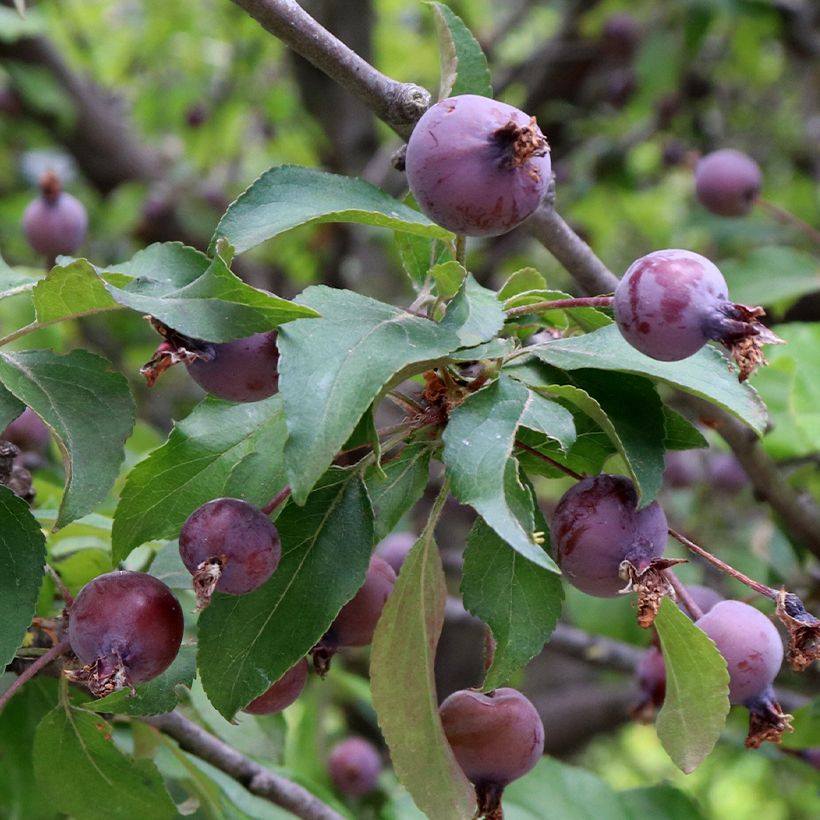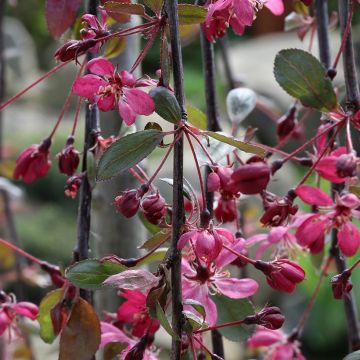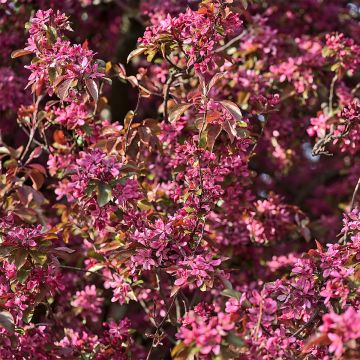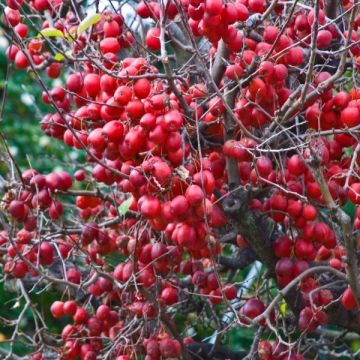

Malus purpureus Aldenhamensis - Crab Apple


Malus purpureus Aldenhamensis - Crab Apple


Malus purpureus Aldenhamensis - Crab Apple
Malus purpureus Aldenhamensis - Crab Apple
Malus x purpureus Aldenhamensis
Apple Tree, Crab Apple
Why not try an alternative variety in stock?
View all →This plant carries a 24 months recovery warranty
More information
We guarantee the quality of our plants for a full growing cycle, and will replace at our expense any plant that fails to recover under normal climatic and planting conditions.
From €5.90 for pickup delivery and €6.90 for home delivery
Express home delivery from €8.90.
Does this plant fit my garden?
Set up your Plantfit profile →
Description
Malus `x purpurea Aldenhamensis is one of the smallest ornamental apple trees, with an adult size that will not exceed 3m (10ft) in all directions. With a strong identity, it is also one of the most decorative, due to its early deep pink flowers, the beauty of its foliage, and its abundant and colourful fruits that ripens late in autumn. From early spring to early winter, a beautiful range of pink-purple, light pink, purple, brown, bronze, and violet tones succeed each other on the vegetation of this resilient little tree. This old variety, easy to grow in ordinary soil, undoubtedly deserves to be rediscovered.
Ornamental apple trees are derived from various botanical species of the Malus genus belonging to the Rosaceae family. Hardy, adaptable, and easy to grow, flowering apple trees thrive in ordinary soil but prefer deep, loose, and moist loam and sunny a position. Once established, they can thrive even if neglected, while retaining their beautiful appearance. 'Aldenhamensis' was discovered in England in 1915.
'Aldenhamensis' descends from Malus (x) purpurea, the purple-fruited apple tree. The latter is a horticultural hybrid created around 1900. A large shrub or small tree, it has a stocky habit and becomes as wide as it is tall: its short trunk supports a rounded and wide crown, giving this apple tree a bushy yet distinctly spreading silhouette. Its growth is quite slow, with average dimensions at maturity of about 2.75 m (9ft) in height and 3 m (10ft) in spread. It maintains a beautiful shape without the need for pruning and develops relaxed wood covered with a smooth brown bark that darkens and flakes with age.
Flowering occurs in early April, more or less early depending on the region. It takes the form of numerous buds of a deep reddish-brown colour. They open into single and semi-double flowers with a diameter of 4 cm (2in), initially dark red-purple and quickly becoming light purple. These flowers, grouped in small clusters, bloom before the young leaves. The flowering is followed by the formation of a multitude of small apples resembling cherries, with a diameter of 2 cm (1in). When ripe in October-November, they are brown-purple to bronze-washed violet. Highly appreciated by birds, these fruits remain on the bush during half of the winter, until December. The deciduous foliage is beautifully coloured: the young leaves emerge purple and then become bronze, remaining bronze-green until summer and turning yellow-orange before falling quite late.
Malus Aldenhamensis, like many flowering apple trees, is a good pollinator for early-flowering fruit trees. This small tree has more presence than a flowering cherry tree. Its abundant flowers may be less long-lasting than that of the cherry, but this detail is compensated for by its eye-catching foliage from spring to autumn, the beauty of its fruits, and its elegant habit. It will find its place in gardens of all sizes, in a free hedge, for example, accompanying large English bush roses or climbing roses trained as bushes, hawthorns, lilacs, or serviceberries. When space is available, ornamental apple trees, planted in a large hedge on a slope, create a rather enchanting scene not only in spring but also in autumn, due to their often sumptuous colours at the end of the season.
Report an error about the product description
Malus purpureus Aldenhamensis - Crab Apple in pictures






Plant habit
Flowering
Foliage
Botanical data
Malus
x purpureus
Aldenhamensis
Rosaceae
Apple Tree, Crab Apple
Cultivar or hybrid
Other Malus - Crabapple
Planting and care
Easy to grow in ordinary soil (slightly acidic to slightly alkaline), Malus 'Aldenhamensis' requires a bright, sunny and open position. Ornamental Malus trees are generally very accommodating, but they like fertile, moist and deep soils. After careful planting and accompanied by regular watering during the first two years, they can manage on their own. Install them in full sun or partial shade, giving them room to spread out. Dig a large planting hole. If the soil is poor, add compost to the planting soil and apply fertilizer or compost around the base of the tree every spring.
Planting period
Intended location
Care
This item has not been reviewed yet - be the first to leave a review about it.
Haven't found what you were looking for?
Hardiness is the lowest winter temperature a plant can endure without suffering serious damage or even dying. However, hardiness is affected by location (a sheltered area, such as a patio), protection (winter cover) and soil type (hardiness is improved by well-drained soil).

Photo Sharing Terms & Conditions
In order to encourage gardeners to interact and share their experiences, Promesse de fleurs offers various media enabling content to be uploaded onto its Site - in particular via the ‘Photo sharing’ module.
The User agrees to refrain from:
- Posting any content that is illegal, prejudicial, insulting, racist, inciteful to hatred, revisionist, contrary to public decency, that infringes on privacy or on the privacy rights of third parties, in particular the publicity rights of persons and goods, intellectual property rights, or the right to privacy.
- Submitting content on behalf of a third party;
- Impersonate the identity of a third party and/or publish any personal information about a third party;
In general, the User undertakes to refrain from any unethical behaviour.
All Content (in particular text, comments, files, images, photos, videos, creative works, etc.), which may be subject to property or intellectual property rights, image or other private rights, shall remain the property of the User, subject to the limited rights granted by the terms of the licence granted by Promesse de fleurs as stated below. Users are at liberty to publish or not to publish such Content on the Site, notably via the ‘Photo Sharing’ facility, and accept that this Content shall be made public and freely accessible, notably on the Internet.
Users further acknowledge, undertake to have ,and guarantee that they hold all necessary rights and permissions to publish such material on the Site, in particular with regard to the legislation in force pertaining to any privacy, property, intellectual property, image, or contractual rights, or rights of any other nature. By publishing such Content on the Site, Users acknowledge accepting full liability as publishers of the Content within the meaning of the law, and grant Promesse de fleurs, free of charge, an inclusive, worldwide licence for the said Content for the entire duration of its publication, including all reproduction, representation, up/downloading, displaying, performing, transmission, and storage rights.
Users also grant permission for their name to be linked to the Content and accept that this link may not always be made available.
By engaging in posting material, Users consent to their Content becoming automatically accessible on the Internet, in particular on other sites and/or blogs and/or web pages of the Promesse de fleurs site, including in particular social pages and the Promesse de fleurs catalogue.
Users may secure the removal of entrusted content free of charge by issuing a simple request via our contact form.
The flowering period indicated on our website applies to countries and regions located in USDA zone 8 (France, the United Kingdom, Ireland, the Netherlands, etc.)
It will vary according to where you live:
- In zones 9 to 10 (Italy, Spain, Greece, etc.), flowering will occur about 2 to 4 weeks earlier.
- In zones 6 to 7 (Germany, Poland, Slovenia, and lower mountainous regions), flowering will be delayed by 2 to 3 weeks.
- In zone 5 (Central Europe, Scandinavia), blooming will be delayed by 3 to 5 weeks.
In temperate climates, pruning of spring-flowering shrubs (forsythia, spireas, etc.) should be done just after flowering.
Pruning of summer-flowering shrubs (Indian Lilac, Perovskia, etc.) can be done in winter or spring.
In cold regions as well as with frost-sensitive plants, avoid pruning too early when severe frosts may still occur.
The planting period indicated on our website applies to countries and regions located in USDA zone 8 (France, United Kingdom, Ireland, Netherlands).
It will vary according to where you live:
- In Mediterranean zones (Marseille, Madrid, Milan, etc.), autumn and winter are the best planting periods.
- In continental zones (Strasbourg, Munich, Vienna, etc.), delay planting by 2 to 3 weeks in spring and bring it forward by 2 to 4 weeks in autumn.
- In mountainous regions (the Alps, Pyrenees, Carpathians, etc.), it is best to plant in late spring (May-June) or late summer (August-September).
The harvesting period indicated on our website applies to countries and regions in USDA zone 8 (France, England, Ireland, the Netherlands).
In colder areas (Scandinavia, Poland, Austria...) fruit and vegetable harvests are likely to be delayed by 3-4 weeks.
In warmer areas (Italy, Spain, Greece, etc.), harvesting will probably take place earlier, depending on weather conditions.
The sowing periods indicated on our website apply to countries and regions within USDA Zone 8 (France, UK, Ireland, Netherlands).
In colder areas (Scandinavia, Poland, Austria...), delay any outdoor sowing by 3-4 weeks, or sow under glass.
In warmer climes (Italy, Spain, Greece, etc.), bring outdoor sowing forward by a few weeks.















































